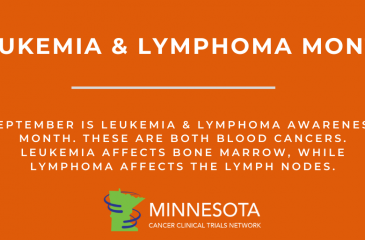Blood Cancer Awareness: History of Bone Marrow Transplantation
September is Leukemia & Lymphoma Awareness Month. These common cancers are both types of blood cancer. Leukemia affects the blood and bone marrow, while lymphoma affects the lymph nodes. In 2020, about 60,000 people will be diagnosed with leukemia, and about 80,000 will be diagnosed with lymphoma.
Leukemia occurs when the bone marrow produces too many abnormal white blood cells. Over time, the abnormal cells outnumber and suppress the development of normal cells, leaving less room for red blood cells to carry oxygen throughout the body.
Lymphoma begins in the immune system and affects the lymph nodes and white blood cells called lymphocytes. Abnormal cells grow quickly and develop into tumors or growth in the lymph nodes.
Both leukemia and lymphoma can be treated in certain cases with bone marrow transplants. Bone marrow is the fatty, spongy tissue in the bones. It creates red blood cells, white blood cells, and platelets.
A bone marrow transplant replaces bone marrow that has been damaged or destroyed by disease, such as leukemia or lymphoma. Healthy blood stem cells, from one’s own body or from a donor, are transplanted so they will produce new blood cells and grow new healthy marrow.
The history of transplantation goes back to ancient times. The idea of removing unhealthy organs and replacing them with healthy ones was written extensively in history. However, bone marrow transplants didn’t become a common idea until the 1940s. During and after World War II, people needed skin grafts, blood transfusions, and more. Researchers studied why these procedures often led to the person’s body rejecting donor skin or blood. Researchers also discovered that exposure to radiation, which many people experienced during the war, led to bone marrow failure or death.
Researchers determined the body rejecting organs or blood from another person was due to the immune system. In the 1950s, researchers experimented with bone marrow grafts in animals exposed to radiation. These studies led to experimentation with people. However, these procedures were unsuccessful due to the body rejecting donor marrow. It was not known at this time that the bone marrow donor needed to be a genetic match.
In 1956, the first successful bone marrow transplant was performed by Dr. E. Donnall Thomas in Cooperstown, New York. A child with leukemia received a transplant with bone marrow from their identical twin. Two years later, French immunologist Dr. Jean Dausset discovered human leukocyte antigens (HLA). This group of proteins regulates the immune system and recognizes what belongs in the body and what does not. HLA compatibility between recipient and donor is vital for a successful transplant.
In 1968, the first bone marrow transplant with a matched related donor occurred at the University of Minnesota. Dr. Robert Good completed the procedure on David Camp, a baby with a severe immune deficiency, using marrow donated by David’s nine-year-old sister, who was an HLA match. The match was determined by a blood test developed by Dr. Fritz Bach at the University of Wisconsin-Madison.
This history-making procedure paved the way for bone marrow transplants. In 1973, the first successful bone marrow transplant with unrelated patients occurred. In the 1980s, the National Marrow Donor Program and the Bone Marrow Donors Worldwide program were established, finally making it possible for patients to be matched with unrelated donors.
In the 1990s, transplants with stem cells in umbilical cord blood began to be used as well. Cord blood allows for mismatched transplants. Therapeutic advances have also allowed for half-matched transplants, such as from a parent or child, in recent years.
Finding a bone marrow donor, something very limited just decades ago, is a simpler, and typically quicker, process today. In the United States, more than 22 million potential bone marrow donors are registered. More than 300,000 cord blood units are registered as well. More than one million bone marrow transplants have occurred worldwide.
However, there are racial disparities when it comes to bone marrow transplants. Caucasian Americans find unrelated donors much more frequently than other races and ethnicities, with 75 percent of patients finding donors. African American patients find unrelated donors only 25 percent of the time. Asian patients and Hispanic patients find unrelated donors 40 and 45 percent respectively.
Further work and research need to be done to close these gaps and make sure all people have the same access to the matches necessary for this live-saving procedure. Researchers are also developing ways to make bone marrow transplants safer, reduce complications, and potentially treat other diseases.
